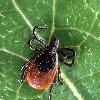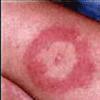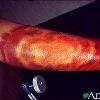

cropped Tags: Lyme Disease View |
shingles appear as a blistering skin rash that can last for several weeks It s very uncomfortable and some people Lyme Disease don t panic just get informed Examiner com Examiner com May 13 2008Lyme Disease is usually treatable when caught early so your next step is to watch for a rash and other Lyme symptoms The rash is called erythema migrans Tags: Lyme Disease View |
Lyme disease erythema chronicum migrans Erythema chronicum migrans is the initial lesion of Lyme disease and often appears at the site of the infecting tick bite It is a red enlarging rash flat or slightly raised and may reach Tags: Lyme Disease View |
|||||||||
Lyme disease, or lyme borreliosis, is an emerging infectious disease caused by at least three species of bacteria belonging to the genus Borrelia. Borrelia burgdorferi sensu lato (sensu stricto) is the main cause of Lyme disease in the United States, whereas Borrelia afzelii and Borrelia garinii cause most European cases. The disease is named after the town of Lyme (Lyme, Connecticut), Connecticut, USA, where a number of cases were identified in 1975. Although Allen Steere realized in 1978 that Lyme disease was a tick-borne disease, the cause of the disease remained a mystery until 1982, when B. burgdorferi was identified by Willy Burgdorfer.
Lyme disease is the most common tick-borne disease in the Northern Hemisphere. Borrelia is transmitted to humans by the bite of infected ticks belonging to a few species of the genus Ixodes ("hard ticks"). Early symptoms may include fever, headache, fatigue (fatigue (medical)), depression (Depression (mood)), and a characteristic circular skin rash called erythema migrans (Erythema chronicum migrans). Left untreated, later symptoms may involve the joints, heart, and central nervous system. In most cases, the infection and its symptoms are eliminated by antibiotics, especially if the illness is treated early.Citation neededdate=December 2009 Late, delayed, or inadequate treatment can lead to the more serious symptoms, which can be disabling and difficult to treat. Occasionally, symptoms such as arthritis persist after the infection has been eliminated by antibiotics, prompting suggestions that Borrelia causes autoimmunity.
Some groups have argued that "chronic" Lyme disease is responsible for a range of medically unexplained symptoms beyond the recognized symptoms of late Lyme disease, and that additional, long-term antibiotic treatments are needed. Of four randomized controlled trials of long-term ceftriaxone and doxycycline treatment in patients with ongoing symptoms, two found no benefit, and two found inconsistent benefits with significant side effects and risks from the antibiotic treatment. Most expert groups, including the Infectious Diseases Society of America and the American Academy of Neurology, have found that existing scientific evidence does not support a role for Borrelia nor ongoing antibiotic treatment in such cases. However, the subject is controversial, with some doctors, patient advocacy groups, and politicians continuing to argue that long-term treatment is beneficial. This dispute has led to legal action over treatment guidelines, as well as harassment and death threats made against physicians who will not acknowledge "chronic" Lyme disease as a legitimate diagnosis.
Diseasesdb: 1531
Icd10: ICD10A692a65
Icd9: ICD9088.81
Medlineplus: 001319
Emedicinesubj: med
Emedicinetopic: 1346
Emedicine Mult: eMedicine2ped1331 eMedicine2neuro521 eMedicine2emerg588
Meshid: D008193



